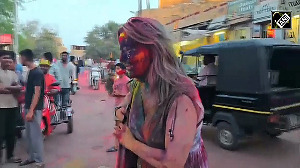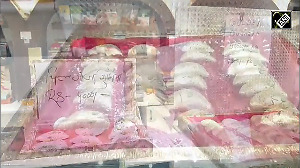The demolition man has been halted. It seems that Mumbai will have to wait for that gleaming, polished look. Its dream to look in the mirror and say Shanghai has been abruptly broken.
Maharashtra Chief Minister Vilasrao Deshmukh had taken a gamble. He had hoped the usual post-election honeymoon period would bestow him the power to bulldoze through his plan for a modern city with world-class infrastructure. Notwithstanding the state's Rs 93,000 crore deficit, Deshmukh bravely asked for Rs 31,000 crore for the makeover.
In Mumbai contrasts are stark and almost surreal. Depending on which side of the starkness you found yourself in, demolitions brought either hope or utter despondency.
But contrasts never paint the complete picture.
Those who had till recently an 'illegal' roof over their head could see what hit them, but couldn't fathom why. 'Where can we go?' That, in approximation, was the question one heard.
Those with a 'legal' roof over the head had a word of sympathy for those out on the streets. But their resolve was steely. 'Unfortunate. But Mumbai is dying; something had to be done.' That, in approximation, was the answer to the question put.
The truth, as is usually the case, doesn't lie in between. It lies elsewhere. Shattered and scattered with each participant hiding a part of it. One part of the truth is when a poor man from a sterile, lifeless village with nothing to satiate the hunger in his stomach, or heart, comes in search of the proverbial pot of gold to Mumbai. Once in the city, he is confronted with the problem of finding a roof over his head.
It would be simplistic to think that a disempowered man comes to a city like Mumbai, chooses a piece of land unbridled and decides to set up his shanty. What is not simplistic, however, and a part of the truth puzzle, is the way the land mafia operates. It grabs land and then rents, leases out or sells it to the poor man looking for a roof over his head.
In short, in a modern, urban setting you have a carefully constructed feudal set-up where the land-grabber -- read Mafiosi -- more or less owns the people living on it.
Possessing one more part of the truth puzzle are the bureaucrats. These modern-day 'feudal rent collectors' with the right kind of grease make the impossible possible. Most of it is euphemistically called 'legalisation process'. Whether it is electricity and water connections or ration and ID cards, everything is available for a price.
In a burgeoning city with little or no natural land, builders enjoy tremendous power. They, in turn, fit a part of the jigsaw puzzle. They are a rich source of funding for the ever-hungry politicians, and in turn are allowed a free use of the muscle of the mafia and the bureaucratic ink of the formidable civic administration.
Politicians fit the other part of the truth puzzle. Power is what the politicians want and, fortunately or unfortunately for them, it flows from the ballot boxes. What better way to get ballot boxes filled than have captive audiences, which the land mafia gladly provides, of course, for a price.
Putting together the pieces makes for an ugly picture. But that ugly picture is the truth. What Vilasrao Deshmukh set out to do was to disturb this picture.
Mumbai 2020: Dream or nightmare?
Not that Deshmukh is a knight in shining armour. His critics consider him part of the power framework that has come to redefine the concept of urban development. They are already hauling him over the coals for his surreptitious amendment to the Development Control Rules called DCR 58 -- in 2001 that gave mill-owners almost complete control of 585-acre Girgaon mill district.(DCR 58 was promulgated in 1991. According to the law one third of the mill land was to go to the BrihanMumbai Municipal Corporation for public amenities, while another third was to go to the Maharashtra Housing Area Development Authority for social housing and the remaining third to the mill-owner, who could exploit development rights (called floor space index). But in 2001, Deshmukh, in his first chief ministerial stint, amended the rule to exclude all built-up area in a mill complex. That allowed mill-owners to keep most, or even all, of the land, depriving the city of a whopping 350 acres of land).
What has irked his critics even more is the appointment of a committee, which they say, is a sham, to re-look at the developments efforts of the mill-owners and big builders. They ask a question to which Deshmukh hasn't given a satisfactory reply till date. 'How can the chairman of a bank (HDFC Bank's Deepak Parekh) which has given more than 50 crores in loans to these very builders and mill-owners be the chairman of the committee?'
Despite the muck, Deshmukh's efforts at cleaning up Mumbai were needed. Almost 60 per cent of Mumbai's population of 18 million plus lives in slums. That is a staggering figure by any standard; something which any city cannot be proud of.
The roots of Deshmukh's current drive lie in a commissioned report submitted by McKinsey in September 2003. The global consulting giant was asked by an NGO -- Bombay First -- to prepare a comprehensive plan for the metropolis. (It is important to note here that Bombay First has several representatives of the corporate world) McKinsey's plan for the city along with the government's strategy together came to be called 'Vision Mumbai' project. The government promptly created a task force, which submitted that Rs 200,000 crore was required to turn Mumbai into a world-class city by 2013.
The McKinsey report highlighted six key areas: economic growth, transportation, housing, other infrastructure (safe water, sanitation, health facilities reduction of pollution), financing of projects and governance. The report said Mumbai needed 8 to 10 per cent sustained economic growth for the next ten years (The city's current growth rate per annum is 2.4%).
For that kind of growth, the report said the city should be able to create 50 lakh (5 million) jobs, increase land availability for 50 to 70 per cent, apart from increasing the FSI and loosening coastal zone regulations.
The report also recommended the abolition of the Rent Control and the Urban Ceiling Act. The report has since then attracted its fair share of criticism, particularly its emphasis on road and flyovers instead of mass transport systems and its suggestion to corporatise sections of the BMC.
The question that comes uppermost in my mind is what does this halt to Mumbai's makeover mean for the rest of India? Backing Deshmukh in his efforts was Prime Minister Manmohan Singh, who is keen to promote the National Urban Renewal Mission. If reports are to be believed a whopping Rs 1,26,786 crore will be set aside and 60 cities will be given a comprehensive makeover.
Apart from the seven mega cities of Delhi, Mumbai, Ahmedabad, Bangalore, Chennai, Kolkata and Hyderabad, 29 cities with million plus population and 24 other cities with less than one million population will come under the Mission's radar. The Mission's heartening aspect is its timeframe -- five years for the makeover -- and its decentralised approach involving the Centre, the states' urban local bodies and financial institutions.
Both Deshmukh and Singh are right in their urges to develop the cities of India into gleaming, world-class metropolises. By stressing rehabilitation over demolition, Congress chief Sonia Gandhi has shown that her heart is in the right place. Despite differences in approach, Deshmukh, Singh and Sonia limit themselves by believing that the solution to urban problems lies in the urban environment.
The endless cycle of demolition and rehabilitation cannot end till the incestuous network between the land mafia, bureaucracy, builders and politicians is not shattered. That incestuous network cannot be dismantled till you make sure that men and women do not migrate from rural to urban areas under distress and because of dispossession. A distressed, dispossessed man is ripe for exploitation.
What does it mean in real terms? The need for a strong and solid political will, for one. It also means that that Singh, Sonia and Deshmukh should implement what has been promised in the Common Minimum Programme -- liberalisation with a 'human' face. Sonia Gandhi has interpreted the 'human' as rehabilitation, which will cost Rs 24,000 crore.
'Human' should be interpreted as evolving a sustainable rural development model that does not force men and women to flock to the city. In concrete terms, the UPA government should invest time and money in agriculture, adding value to it and making it an 'industry' good enough to provide sustainable employment for 12 whole months.
At the risk of sounding politically incorrect and being accused of urban-centric elitism, the model of development for urban and rural areas has to be different. While a certain synergy may be found between the two models, one has to proceed with the idea of adding value to agriculture so that it moves from being an occupation to an industry. That would mean far-reaching reforms in the agriculture sector, including widespread land reforms, de-regulating markets, doing away with minimum support prices and reducing, and eventually ending, subsidies.
The real urban solution lies in men and women in villages finding no reason to shift to cities. That is the challenge that Deshmukh, Singh and Sonia should face up to.
Ramanathan Swaminathan, PhD, formerly a deputy news editor at rediff.com, is currently associated with the Observer Research Foundation.






 © 2025
© 2025